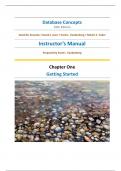Exam (elaborations)
Solution Manual for Database Concepts, 10th Edition by David M. Kroenke, David J. Auer, Scott L. Vandenberg, Robert C. Yoder
- Course
- Institution
Solution Manual for Database Concepts 10th Edition by David M. Kroenke, David J. Auer, Scott L. Vandenberg, Robert C. Yoder
[Show more]



